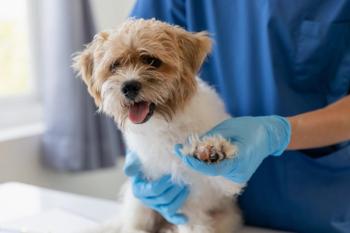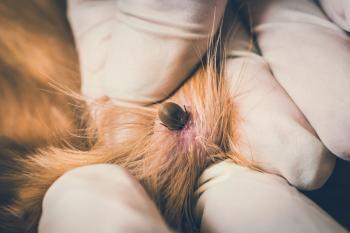
Four types of veterinary imaging help save Maddie the Yorkie
BluePearl team uses radiography, ultrasound, bronchoscopy and fluoroscopy to manage acute respiratory crisis.
When a Yorkshire terrier named Maddie started coughing so badly she could barely breathe, the Cassel family cut their vacation a day short so they could get to their veterinary hospital.
Maddie's severe respiratory distress might have killed her a decade ago. But Maddie's veterinarians at BluePearl Specialty & Emergency Veterinary Care in Southfield, Michigan, used four types of imaging to diagnose and treat her condition: radiographs, ultrasound, bronchoscopy and fluoroscopy.
“It's like a person going in to the hospital,” said Maddie's owner Prudy Cassel in a release from BluePearl. “To know that they can give this kind of care to an animal and be just as successful as on a human being, I think that's amazing.”
Maddie's story began with a family trip to northern Michigan for kayaking and relaxing.
The dog, age 7, began breathing heavily and could not get to sleep in the cabin at night. Prudy's husband, David Cassel, stayed up with her all night. They drove the next day to the BluePearl hospital in Southfield, cutting their trip short by a day. Maddie had been a heavy breather for years, but this time she was clearly in trouble.
Maddie was in extreme respiratory distress on presentation, requiring immediate sedation and oxygen therapy. Radiographs identified complete consolidation of her left caudal lung lobe, consistent with pneumonia, along with severe tracheal collapse at the thoracic inlet.
A radiograph showing the area of the collapsed trachea (blue arrow). All images courtesy of BluePearl.Maddie was admitted to BluePearl's intensive care unit, where her treatment included ongoing oxygen therapy, broad-spectrum antibiotics, intravenous fluid therapy, and nebulization. Over the next few days she became less dyspneic and was weaned off oxygen, but she remained lethargic with very loud stridor and a cough easily triggered with the slightest movement.
Jessica Romine, DVM, DACVIM, who recently completed her residency in internal medicine at BluePearl, wanted to investigate the possibility of a collapsed trachea. A collapsed trachea normally is a degenerative condition in older dogs, and Maddie was only 7. But Dr. Romine was aware of new studies identifying a specific subset of Yorkshire terriers with congenital tracheal malformations rather than traditional cartilage degeneration.
A bronchoscopy image shows that the trachea is almost completely occluded.Michelle Rose, DVM, MS, DACVR, a BluePearl radiologist, performed an abdominal ultrasound to make sure there wasn't any other obvious reason for the persistent lung consolidation, as well as an extrathoracic tracheal ultrasound to rule out an obvious intraluminal tumor, another possibility based on radiographs. Dr. Romine also performed a bronchoscopy, which confirmed that Maddie's trachea was collapsed, right at the location most often affected by these congenital malformations. “The thoracic inlet was almost completely occluded,” she said.
This condition explained why Maddie was in such severe distress. “This pneumonia sent her into a crisis, and it probably wouldn't have without this congenital defect,” Dr. Romine said.
The next step was to place a stent in Maddie's trachea to keep her airway open. A variety of lengths and diameters of stents are available and placing the right one is critical. That's one reason Dr. Romine chose to use fluoroscopy in this procedure. By examining her progress through the video images provided by fluoroscopy, she could watch the procedure in real time, as she was doing it. She placed two stents to provide extra support at the point of collapse, knowing the congenital cases are more prone to reobstruction over time.
Flouroscopy was used as Dr. Romine placed the stent in the trachea.Afterward, Maddie was still recovering from the pneumonia, but her loud, honking cough had gone away. Even under light anesthesia Maddie had been coughing in the fluoroscopy procedure, but as soon as the stents were placed she began breathing deeply and quietly.
“She was immediately doing better and we were able to discharge her the next day,” Dr. Romine said. At her first recheck a week later, Maddie's pneumonia had almost completely resolved. She will need to be monitored over time to ensure the stent does not migrate or fracture, but with medical management the BluePearl doctors have high expectations for Maddie long-term.
In fact, Prudy Cassel says the family had gotten so used to Maddie's loud breathing that it took a while to get used to her not doing it. Sometimes she still wonders where Maddie is, only to find that the dog is right next to her.
“To us as a family, it's like a miracle,” she said.
Newsletter
From exam room tips to practice management insights, get trusted veterinary news delivered straight to your inbox—subscribe to dvm360.






